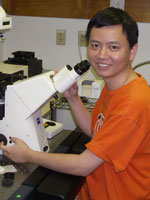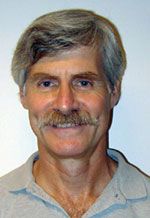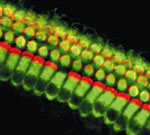 |

For further information, contact the MBL Communications Office at (508) 289-7423 or e-mail us at comm@mbl.edu
For Release: September 24, 2007
Contact: Gina Hebert, MBL, 508-289-7725; ghebert@mbl.edu
New Cell Culturing Method Pumps Up the Volume for Hearing Loss Researchers
 |
|
 |
Resources:
Photos: (Click on thumbnails for high-resolution images)

Zhengqing Hu, Research Associate in Neuroscience, University of Virginia School of Medicine

MBL Whitman Investigator Jeffrey Corwin

Hair cells from the cochlea of a mouse. Image by Jason Meyers, Assistant Professor of Biology, Colgate University

A single hair cell from a frog ear magnified by a scanning electron microscope. Hair cells are essential sound and balance detectors in the inner ear. The study of these cells, which are a limited commodity and easily damaged in humans, is key to understanding hearing and balance loss. Image by Jason Meyers, Assistant Professor of Biology, Colgate University
Citation:
PNAS Article #07-4576: "Inner Ear Hair Cells Produced In Vitro Via A Mesenchymal-To-Epithelial Transition" by Zhengqing Hu and Jeffrey T. Corwin.
For full text of this paper, media can contact the PNAS press office, PNASnews@nas.edu.
Background:
Outside Experts Available for Comment:
Matthew W. Kelley, Ph.D.
Chief, Developmental Neuroscience Section
NIDCD/NIH
Porter Neuroscience Research Center
Kelleymt@nidcd.nih.gov
David P. Corey, Ph.D.
Professor and Interim Chair
Department of Neurobiology
Harvard Medical School
dcorey@hms.harvard.edu
Professor Matthew Holley
Department of Biomedical Science
The University of Sheffield
M.C.Holley@sheffield.ac.uk
Funders:
|
MBL, WOODS HOLE, MA—In a breakthrough that will likely accelerate research aimed at cures for hearing loss, tinnitus, and balance problems, scientists have perfected a laboratory culturing technique that provides a reliable new source of cells critical to understanding certain inner-ear disorders.
The cells, known as hair cells, are the essential sound and balance detectors in the inner ear. Damage to these cells is a key factor in hearing and balance loss, and while birds, fishes, and amphibians can quickly regrow damaged hair cells, humans cannot. Until now, scientists seeking clues to this problem have been hampered by difficult procedures required to gather these cells for their research.
In the September 24-28 early edition of the Proceedings of the National Academy of Sciences (PNAS), MBL Whitman Investigators Zhengqing Hu and Jeffrey Corwin, both of the University of Virginia School of Medicine, describe a new technique for isolating cells from the inner ears of chicken embryos and growing them in their laboratory. The scientists achieved these results by inducing avian cells to differentiate into hair cells via a process known as mesenchymal-to-epithelial transition.
Hu and Corwin were able to freeze and thaw the cultured cells, then grow new cells from the thawed cultures - a discovery that will make hair cells accessible to more researchers.
The study of hair cells is crucial to understanding hearing loss because hair cells are a precious commodity in humans. We are born with a limited number of these sound detectors in each ear, which can be easily damaged by age, certain illnesses, loud noises, and adverse reactions to medications. Once damaged, the cells do not grow back, causing hearing and balance problems.
“Until now, scientists working to understand many inner ear disorders had to resort to difficult microdissections to gather even small numbers of these cells, which limited the types of research that could be pursued and slowed the pace of discoveries,” says Corwin.
The availability of vials of frozen cells that can be induced to form hair cells should remove a significant barrier to progress toward the development of treatments for the more than 20 million Americans who suffer from hearing loss and balance problems.
Dr. Corwin, a professor of neuroscience at the University of Virginia School of Medicine, is a co-director of the MBL’s Biology of the Inner Ear course. He first came to the MBL as a student in the Neurobiology Course in 1975 and returned as a Grass Fellow in 1983 and has conducted summer research at the MBL for a number of years. Dr. Hu is a postdoctoral research associate in neuroscience at University of Virginia School of Medicine, who has conducted research at the MBL during two summers.
The research was supported by two grants from the National Institutes of Health and by the Grass Foundation.
The MBL is an international, independent, nonprofit institution dedicated to discovery and to improving the human condition through creative research and education in the biological, biomedical and environmental sciences. Founded in 1888 as the Marine Biological Laboratory, the MBL is the oldest private marine laboratory in the Western Hemisphere. For more information, visit www.MBL.edu
|